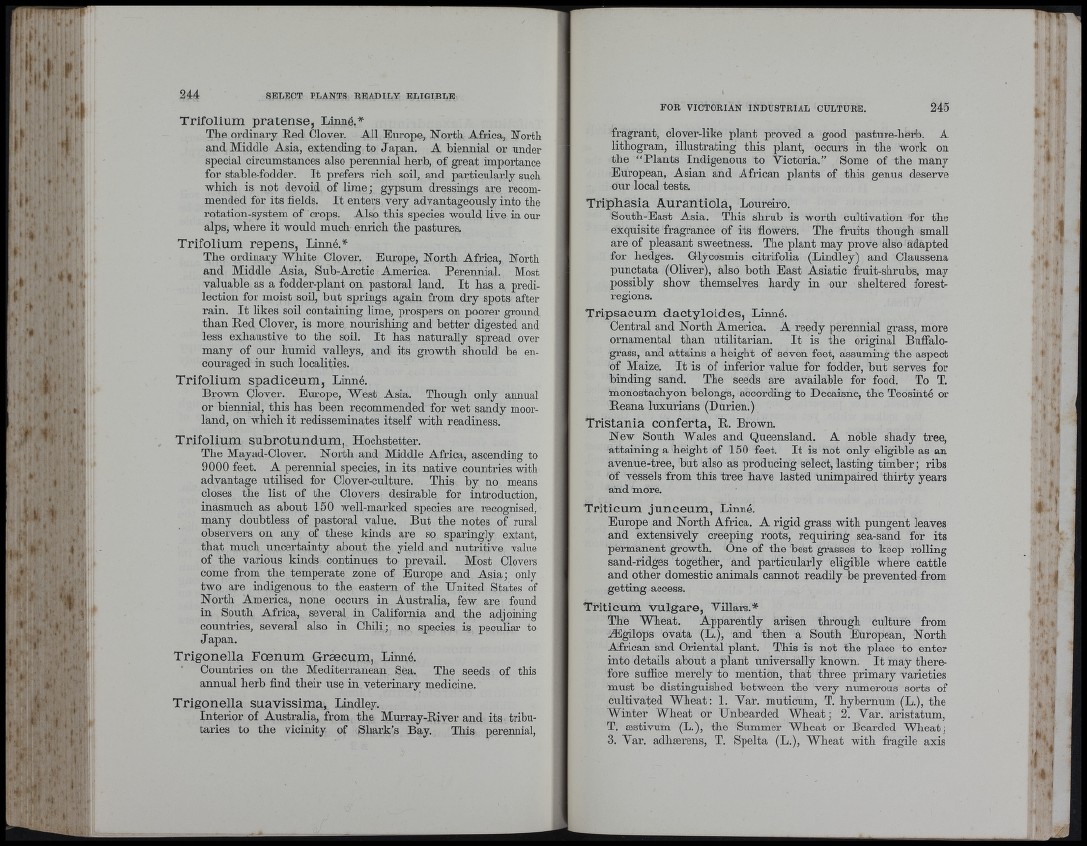
■ ! i
I ,
Trifolium pratense, Linné.*
The ordinary Eed Clover. All Europe, North Africa, North
and Middle Asia, extending to Japan. A biennial or under
special circumstances also perennial herb, of great importance
for stable-fodder. I t prefers rich soil, and particularly such
which is not devoid of lime; gypsum dressings are recommended
for its fields. I t enters very advantageously into the
rotation-system of crops. Also this species would live iu our
alps, where it would much enrich the pastures.
Trifolium repens, Linné.*
The ordinary White Clover. Europe, North Africa, North
and Middle Asia, Sub-Arctic America. Perennial. Most
valuable as a fodder-plant on pastoral land. I t has a predilection
for moist soil, but springs again from dry spots after
rain. I t likes soil containing lime, prospers on poorer ground
than Eed Clover, is more nourishing and better digested and
less exhaustive to the soil. I t has naturally spread over
many of our humid valleys, and its growth should be encouraged
in such localities.
Trifolium spadiceum, Linné.
Brown Clover. Europe, West Asia, Though only annual
or biennial, this has been recommended for wet sandy moorland,
on which it redisseminates itself with readiness.
Trifolium subrotundum, Hochstetter.
The Mayad-Clover. North and Middle Africa, ascending to
9000 feet. A perennial species, in its native countries with
advantage utilised for Clover-culture. This hy no means
closes the list of the Clovers desirable for introduction,
inasmuch as about 150 well-marked species are recognised,
many doubtless of pastoral value. But the notes of rural
observers on any of these kinds are so sparingly extant,
that much uncertainty about the yield and nutritive value
of the various kinds continues to prevail. Most Clovei’s
come from the temperate zone of Europe and Asia; only
two are indigenous to the eastern of the United States of
North America, none occurs in Australia, few are found
in South Africa, several in California and the adjoining
countries, several also in Chili; no species is peculiar to
Japan.
Trigonella Foenum Græcum, Linné.
Countries on the Mediterranean Sea. The seeds of this
annual herb find their use in veterinary medicine.
Trigonella suavissima, Lindley.
Interior of Australia, from the Murray-Eiver and its tributaries
to the vicinity of Shark’s Bay. This perennial.
fragrant, clover-like plant proved a good pasture-herb. A
lithogram, illustrating this plant, occurs in the work on
the “ Plants Indigenous to Victoria.” Some of the many
European, Asian and African plants of this genus deserve
our local tests.
Triphasia Aurantiola, Loureiro,
South-East Asia. This shrub is worth cultivation for the
exquisite fragrance of its flowers. The fruits though small
are of pleasant sweetness. The plant may prove also adapted
for hedges. Glycosmis citrifolia (Lindley) and Claussena
punctata (Oliver), also both East Asiatic fruit-shrubs, may
possibly show themselves hardy in our sheltered forest-
regions,
Tripsacum dactyloides, Linné.
Central and North America. A reedy perennial grass, more
ornamental than utilitarian. I t is the original Bufialo-
grass, and attains a height of seven feet, assuming the aspect
of Maize. I t is of inferior value for fodder, but serves for
binding sand. The seeds are available for food. To T.
monostachyon belongs, according to Decaisne, the Teosinté or
Eeana luxurians (Durien.)
Tristania conferta, E. Brown.
New South Wales and Queensland. A noble shady tree,
attaining a height of 150 feet. I t is not only eligible as an
avenue-tree, but also as producing select, lasting timber ; ribs
of vessels from this tree have lasted unimpaired thirty years
and more.
Triticum junceum, Linné.
Europe and North Africa, A rigid grass with pungent leaves
and extensively creeping roots, requiring sea-sand for its
permanent growth. One of the best grasses to keep rolling
sand-ridges together, and particularly eligible where cattle
and other domestic animals cannot readily be prevented from
getting access.
Triticum vulgare, Yillars.*
The Wheat. Apparently arisen through culture from
Ægilops ovata (L.), and then a South European, North
African and Oriental plant. This is not the place to enter
into details about a plant universally known. I t may therefore
sufiice merely to mention, that three primary varieties
must he distinguished between the very numerous sorts of
cultivated Wheat: 1. Yar, muticum, T, hybernum (L), the
Winter Wheat or Unbearded Wheat; 2, Yar. aristatum,
T. æstivum (L.), the Summer Wheat or Bearded Wheat;
3. Yar. adhærens, T. Spelta (L.), Wheat with fragile axis
Yt